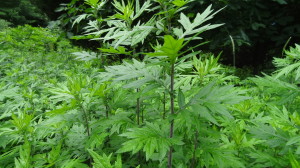
Mugwort (Artemisia vulgaris), also known as Common Wormwood is a very abundant plant in its growing range. It grows in the Eastern US and Northwestern US.
Mugwort is adapted to grow in compact rocky soil where other plants might have a hard time. Mugwort has a long history of use as a medicinal and culinary herb in Europe and Asia where it is native. Although Mugwort is an established culinary herb you should never take Mugwort if you are pregnant, scroll down to our ‘Cautions’ section for details. There are a few other plants in the genus Artemisia that live in the US including Western Mugwort (Artemisia ludoviciana) which grows throughout the entire US. Western Mugwort and others may share some edible and medicinal properties as well as cautions with Mugwort.
Edibility and Culinary Use
Mugwort has a long history of culinary use, it has a unique musty herbal fragrance, the flavor is just as unique and slightly bitter. It is often used dried as a spice for meats. The leaves can be eaten fresh in salads, or cooked in soups. Mugwort has a long history of use in beverages. Mugwort has been added to teas and alcoholic beverages. The acoholic drink absinthe is made from Artemisia absinthium, a plant in the same genus as Mugwort which is also referred to as Common Wormwood. Mugwort was used prior to hops in the making of beer.
Health Benefits
Mugwort has a wide range of health benefits. It is believed to help in digestion so is often eaten with fatty foods like meat as a dried spice. It also is known to aid in a number of digestive tract issues such as diarrhea, cramps, vomiting, and constipation. Mugwort root may help give energy, it is sometimes made into a tea for that purpose. Mugwort has a long history of assisting women with irregular periods and in reducing menstrual cramp pain. Mugwort also has a number of uses in the treatment of mood disorders such as anxiety, depression, insomnia, and irritability. Some people find that Mugwort has dream enhancing properties, there is a long history of use for this purpose, it was taken as a tea or dried and smoked before going to bed.
Key ID Features
Cautions
Mugwort does contain some components that might be harmful under certain circumstances. Women who are pregnant should never take mugwort, because it tightens the uterus and could potentially cause a miscarriage, especially early in pregnancy. Over-consumption of Mugwort should be avoided by everyone because it could have some mild toxic effects if taken in large quantities
Conclusion
Mugwort is an abundant weed that many people have little appreciation for, but in reality it is a plant with a long history of use as a medicinal and culinary herb. Early in my foraging days I never looked twice at Mugwort but now I nibble on it often and use it in teas and spices. With so many health benefits Mugowort is yet another plant that hides secrets to a healthy lifestyle. Science would learn a lot from thoroughly researching the chemical components of this plant.
Many of our readers find that subscribing to Eat The Planet is the best way to make sure they don't miss any of our valuable information about wild edibles.
See our privacy policy for more information about ads on this site







5 Responses
I have 5 books on edible plants and none of them have a listing for mugwort by any of its names. If it is readily available (and I think there is some in my neighbor’s abandoned horse pasture) why is it not listed…at all…in any of these books? Is there any other name it could be called….I have tried mugwort, artemisia vulgaris, common wormwood and wormwood…just to cover all bases….and I get zero. I even tried looking up just “worts”…..same there.
Not sure why it’s not in more books here is some more info on it. http://pfaf.org/user/Plant.aspx?LatinName=Artemisia+vulgaris
When I bought a piece of land in Arizona and found sagebrush in a pasture, I was shocked and did not know what to do with it, because I heard that this plant is a real parasite. But you know, I decided to leave it and I don’t regret it at all. There are so many things you can do with it!!
Fairly certain what has the fuzzy stem is Ragweed, not Mugwort (As per the video). Mugwort has more of a Purplish stem with ridges or lines running horizontally.
I Concur it is Natural NATURE PLANT ?, JUST FOLLOW THE INSTRUCTIONS.